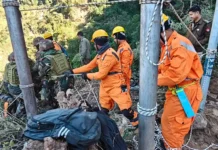WALONG, 13 Apr: The state government has launched an ambitious plan to build 50 mini hydropower projects along the border with China for electrification of remote villages that are facing challenges of poor connectivity and mountainous terrain.
Under the ‘golden jubilee border village illumination programme’, these 50 micro, mini and small hydropower projects of 10 100 kw capacity are being built at an estimated cost of Rs 200 crore.
“The 50 projects are being implemented in a phased manner and under Phase-I, 17 projects with an installed capacity of 1,255 kw and at an estimated cost of Rs 50 crore, have been taken up,” Chief Minister Pema Khandu told PTI during a visit here.
These are standalone projects and include localised transmission and distribution components to facilitate essential services to the border villages in one go.
The chief minister said that lack of reliable power supply due to limitations in providing grid connectivity to these remote areas is a huge constraint for civilians as well as the border-guarding forces deployed in the region.
The forces are dependent on diesel generators for power which is costly.
“Ample presence of water resources like rivers and natural springs along with heavy rainfall in the mountainous border regions of the state serve as a great advantage in extraction of energy from micro-hydel projects,” Khandu said.
Deputy Chief Minister Chowna Mein said that these 17 projects located in 11 districts will cover 123 border villages, benefitting 10,185 people.
“In addition, 15 establishments of the Indian Army, the Indo-Tibetan Border Police and the Border Roads Organisation, covering about 1,800 personnel, will be electrified under these 17 projects,” said Mein, who also holds the charge of the power department.
Union Home Minister Amit Shah, during a visit to Anjaw district on Monday inaugurated nine of these projects, which have a total capacity of 725 kw.
One of these projects, Dichu Nallah (100 kw), is located just along the line of actual control (LAC), near Kibithoo in Anjaw district.
It had faced problems from close scrutiny of the China’s People Liberation Army because of its proximity to the LAC.
“However, despite several hurdles, we could successfully complete the project within a very short span of time. We have also changed the colour of the project from bottle green to red as it is a civilian asset,” said executive engineer of the project Dharmendra Gogoi.
Most of the army utilities in the area are painted green and the red colour denotes it is a civilian asset
Arunachal has the longest international border in the country with a total length of 1,863 kms. Out of the total international boundary, the state shares a 1,126-km border with Tibet.
The deputy chief minister said such projects are not only cost-effective but also environmentally sustainable.
“Arunachal has till date installed many such projects during last few years. In fact, last year the state earned more than four lakhs of carbon credit by generating power through these micro-hydels,” the deputy chief minister said. (PTI)

